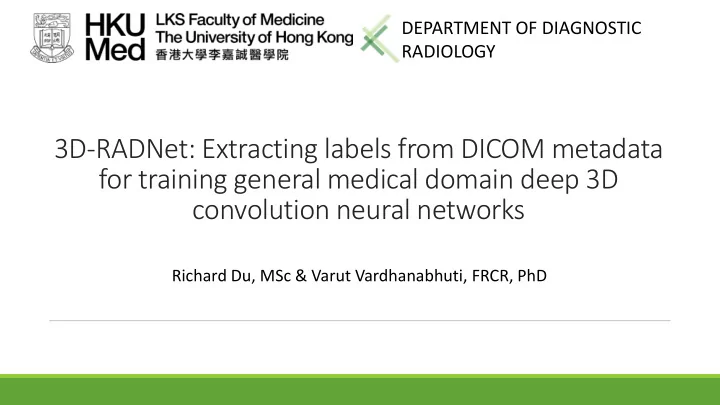

DEPARTMENT OF DIAGNOSTIC RADIOLOGY 3D-RADNet: Extracting labels from DICOM metadata for training general medical domain deep 3D convolution neural networks Richard Du, MSc & Varut Vardhanabhuti, FRCR, PhD
DEPARTMENT OF DIAGNOSTIC RADIOLOGY Purpose Training deep convolution neural network requires a large amount of data Transfer learning from pre -existing large datasets are typically to improve performance. Labelling large amount of medical images maybe difficult due to expert domain knowledge Lack of large datasets for 3D medical images
DEPARTMENT OF DIAGNOSTIC RADIOLOGY Related Work Tencent MedicalNet (Chen et al. 2019) 3D CNN (3D ResNet) trained on segmentation data Large dataset involving mainly public dataset and private Segmentation data require expert and time consuming annotations References: Sihong Chen, Kai Ma, and Yefeng Zheng. Med3D: Transfer Learning for 3D Medical Image Analysis. CoRR, abs/1904.00625, 2019. URL http://arxiv.org/abs/1904.00625.
DEPARTMENT OF DIAGNOSTIC RADIOLOGY Our Approach We examined the use of DICOM metadata and also heuristics of the datasets to semi-automatically labelled large amount of medical images. DICOM tags such as modality, sequences and orientations may provide descriptive features of the images to train a network. We applied our method to large cancer dataset (TCIA) consisting of over 60,000+ imaging series.
DEPARTMENT OF DIAGNOSTIC RADIOLOGY Network and Training Adopted ResNet to 3D ResNet Trained to classify the modality/sequences, anatomical planes, presence of contrast agent and body coverage A total of 15305 image series were used for training Hold out test set of 316 series from individual patients were used for evaluation.
DEPARTMENT OF DIAGNOSTIC RADIOLOGY Results
DEPARTMENT OF DIAGNOSTIC RADIOLOGY Experiment Transfer learning to a liver segmentation task (LITS dataset) Standard VNet Architecture with skip connections Region of proposal of liver slices by using a sliding window approach
DEPARTMENT OF DIAGNOSTIC RADIOLOGY Results
DEPARTMENT OF DIAGNOSTIC RADIOLOGY Results
DEPARTMENT OF DIAGNOSTIC RADIOLOGY Summary We devised a strategy to extract useful labels from large amount of medical images to train medical images Network trained from public TCIA datasets can be used for transfer learning onto other tasks. Good segmentation performance can be achieved even with low number of training data
DEPARTMENT OF DIAGNOSTIC RADIOLOGY Thank you very much!
Recommend
More recommend